Portal:Business/Selected picture
Usage
The layout design for these subpages is at Portal:Business/Selected picture/Layout.
- Add a new Selected picture to the next available subpage.
- Update "max=" to new total for its {{Random portal component}} on the main page.
Selected pictures list
Selected picture 1
Portal:Business/Selected picture/1
 Photo credit: Lars Plougmann
Bribery around the world is estimated at about $1 trillion (£494bn). The burden of corruption falls disproportionately on the bottom billion people living in extreme poverty who cannot afford to pay and who thus receive sub-standard treatment from officials. |
Selected picture 2
Portal:Business/Selected picture/2
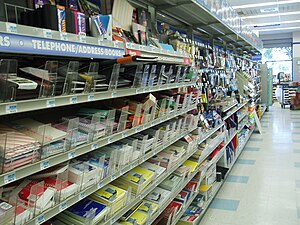 Photo credit:
Marlith
|
Selected picture 3
Portal:Business/Selected picture/3
 Photo credit: Caciss
Seaborne piracy has been affecting trade since the 13th century BC. Seaborne piracy against transport vessels remains a significant issue, with estimated worldwide losses of US $13 to $16 billion per year. |
Selected picture 4
Portal:Business/Selected picture/4
|
Puck magazine .Photo credit: Dontworry
John D. Rockefeller was an American industrialist and philanthropist and founder of Standard Oil. This cartoon from Puck magazine satirizes Rockefeller as an industrial emperor. |
Selected picture 5
Portal:Business/Selected picture/5
 Photo credit: Dontworry
The European Central Bank (ECB) is one of the world's most important central banks, responsible for monetary policy covering the 15 member countries of the Eurozone. It was established by the European Union (EU) in 1998 with its headquarters in Frankfurt, Germany. |
Selected picture 6
Portal:Business/Selected picture/6
 Photo credit: Genghiskhanviet
|
Selected picture 7
Portal:Business/Selected picture/7
 Photo credit: Indianhilbilly
Infosys is a multinational information technology company, with nine development centers in India and over 30 offices worldwide. Infosys and its subsidiaries employ over 80,501 professionals. Its annual revenues for the fiscal year 2006-2007 exceeded US$3.1 billion with a market capitalization of over US$30 billion. |
Selected picture 8
Portal:Business/Selected picture/8
 Photo credit: Erina
This diagram illustrates how to draw a euro symbol, based on official documentation, and has been prepared specifically for Wikipedia and released to the public domain. ADF and BCDE intersect at D. BCDE, GH, and IJ are parallel. BCDE intersects centerline at C. |
Selected picture 9
Portal:Business/Selected picture/9
 Photo credit: User:293.xx.xxx.xx
The 1933 double eagle is a minted in 1933 none were ever officially circulated and all but two were melted down. Supposedly, 20 found their way into the hands of collectors, but 19 of these were subsequently seized or voluntarily turned in to the Secret Service, who destroyed nine of them, making this one of the world's rarest coins. Five are still missing out of the 20.
|
Selected picture 10
Portal:Business/Selected picture/10
|
Brasilia .Photo credit: Genghiskhanviet
The Central Bank of Brazil (Portuguese: Banco Central do Brasil) is Brazil's central bank. It was established on December 31, 1964. The Central Bank is linked with the Ministry of Finance. Like other central banks, the Brazilian central bank is the principal monetary authority of the country. It received this authority when it was founded by three different institutions: the Bureau of Currency and Credit (SUMOC), the Bank of Brazil (BB), and the National Treasury.
One of the main instruments of Brazil's monetary policy is the Banco Central do Brasil's overnight rate, called the SELIC rate. |
Selected picture 11
Portal:Business/Selected picture/11
|
Washington, DC .Photo credit: Genghiskhanviet
The Federal Reserve System (also known as the Federal Reserve, and informally as the Fed) is the central banking system of the United States. It was created on December 23, 1913, with the enactment of the Federal Reserve Act, largely in response to a series of financial panics, particularly a severe panic in 1907. Over time, the roles and responsibilities of the Federal Reserve System have expanded, and its structure has evolved. Events such as the Great Depression in the 1930s were major factors leading to changes in the system.
|
Selected picture 12
Portal:Business/Selected picture/12
 Photo credit: Genghiskhanviet
A farmers' market (also farmers market) is a physical public markets , which are generally housed in permanent structures, open year-round, and offer a variety of non-farmer/producer vendors, packaged foods and non-food products.
|
Selected picture 13
Portal:Business/Selected picture/13
 Photo credit: Genghiskhanviet
A fish market is a fishermen and fish merchants, or to the sale of seafood to individual consumers, or to both. Retail fish markets, a type of wet market, often sell street food as well.
Fish markets range in size from small fish stalls to the great Tsukiji fish market in Tokyo, turning over about 660,000 tonnes a year. |
Selected picture 14
Portal:Business/Selected picture/14
 Photo credit: Genghiskhanviet
The market square (or sometimes, the market place) is a feature of many European and colonial towns. It is an open area where market stalls are traditionally set out for trading, commonly on one particular day of the week known as market day. |
Selected picture 15
Portal:Business/Selected picture/15
 Photo credit: Genghiskhanviet
A shopping mall, shopping centre/center, shopping arcade, shopping precinct, or simply just a mall, is one or more buildings forming a complex of shops representing merchandisers, with interconnecting walkways enabling visitors to walk from unit to unit. Other establishments including movie theaters and restaurants are also often included. |
Selected picture 16
Portal:Business/Selected picture/16
 Photo credit: Genghiskhanviet
A bazaar is a market: a permanent enclosed merchandising area, marketplace, or street of shops where goods and services are exchanged or sold. The term originates from the Middle Persian word vāzār. Souq is another word used in the Middle East for an open-air marketplace or commercial quarter. The term bazaar is sometimes also used to refer to the "network of merchants, bankers, and craftsmen" who work in that area. Although the current meaning of the word is believed to have originated in native Zoroastrian Persia, its use has spread and now has been accepted into the vernacular in countries around the world. The rise of large bazaars and stock trading centers in the Muslim World allowed the creation of new capitals and eventually new empires. New and wealthy cities such as Isfahan, Golconda, Samarkand, Cairo, Baghdad, and Timbuktu were founded along trade routes and bazaars. Street markets and arcades are European and North American equivalents.
|
Selected picture 17
Portal:Business/Selected picture/17
 Photo credit: Raysonho @ Open Grid Scheduler / Grid Engine
A supermarket, a large form of the traditional grocery store, is a self-service shop offering a wide variety of food and household products, organized into aisles. It is larger in size and has a wider selection than a traditional grocery store, but is smaller and more limited in the range of merchandise than a hypermarket or big-box market. |
Selected picture 18
Portal:Business/Selected picture/18
 Photo credit: Genghiskhanviet
In commerce, a hypermarket is a superstore combining a supermarket and a department store . The result is an expansive retail facility carrying a wide range of products under one roof, including full groceries lines and general merchandise. In theory, hypermarkets allow customers to satisfy all their routine shopping needs in one trip.
|
Selected picture 19
Portal:Business/Selected picture/19
 Photo credit: Indianhilbilly
An auction is a process of buying and selling goods or services by offering them up for bid, taking bids, and then selling the item to the highest bidder. In economic theory , an auction may refer to any mechanism or set of trading rules for exchange.
|
Selected picture 20
Portal:Business/Selected picture/20
 A flea market (or swap meet) is a type of bazaar that rents space to people who want to sell or barter merchandise. Used goods, low quality items, and high quality items at low prices are commonplace. |
Selected picture 21
Portal:Business/Selected picture/21
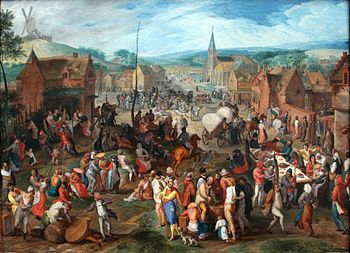 A fair (archaic: faire or fayre) is a gathering of people to display or trade produce or other goods, to parade or display animals and often to enjoy associated trade fairs are important regular business events either where products are traded between businesspeople, as at the Frankfurt Book Fair , where publishers sell book rights in other markets to other publishers, or where products are showcased to consumers, as for example in agricultural districts where they present opportunities to display and demonstrate the latest machinery on the market to farmers.
|
Selected picture 22
Portal:Business/Selected picture/22
 A trade fair (trade show, trade exhibition or expo) is an exhibition organized so that companies in a specific industry can showcase and demonstrate their latest products, service, study activities of rivals and examine recent market trends and opportunities. In contrast to consumer fairs, only some trade fairs are open to the public, while others can only be attended by company representatives (members of the trade, e.g. professionals) and members of the press, therefore trade shows are classified as either "Public" or "Trade Only". A few fairs are hybrids of the two; one example is the Frankfurt Book Fair, which is trade-only for its first three days and open to the general public on its final two days. They are held on a continuing basis in virtually all markets and normally attract companies from around the globe. For example, in the U.S. there are currently over 10,000 trade shows held every year, and several online directories have been established to help organizers, attendees, and marketers identify appropriate events. |
Selected picture 23
Portal:Business/Selected picture/23
 Photo credit: Genghiskhanviet
A tax (from the Latin taxo; "rate") is a financial charge or other levy imposed upon a taxes and may be paid in money or as its labour equivalent. |
Selected picture 24
Portal:Business/Selected picture/24
 Photo credit: Genghiskhanviet
Manufacturing is the production of finished goods on a large scale. Such finished goods may be used for manufacturing other, more complex products, such as aircraft, household appliances or automobiles, or sold to wholesalers, who in turn sell them to retailers, who then sell them to end users – the "consumers".
|
Selected picture 25
Portal:Business/Selected picture/25
 Photo credit: Genghiskhanviet
Logistics is the management of the flow of goods between the point of origin and the point of consumption in order to meet some requirements, of customers or corporations. The resources managed in logistics can include physical items, such as food, materials, animals, equipment and liquids, as well as abstract items, such as time, information, particles, and energy. The logistics of physical items usually involves the integration of information flow, warehousing, and often security. The complexity of logistics can be modeled, analyzed, visualized, and optimized by dedicated simulation software . The minimization of the use of resources is a common motivation in logistics for import and export.
|
Selected picture 26
Portal:Business/Selected picture/26
|
Photo credit: Genghiskhanviet
A farm is an area of land that is devoted primarily to agricultural processes or an area of water that is devoted primarily to aquacultural processes, in order to produce and manage such food production. Farms may be owned and operated by a single individual, family, community, corporation or a company. A farm can be a holding of any size from a fraction of a hectare to several thousand hectares.
|
Selected picture 27
Portal:Business/Selected picture/27
 Barter is a system of exchange by which goods or services are directly exchanged for other goods or services without using a deflationary spiral ) or simply unavailable for conducting commerce.
|
Selected picture 28
Portal:Business/Selected picture/28
 Manual labour (manual labor in American English) or manual work is physical work done by people, most especially in contrast to that done by machines, and also to that done by working animals. It is most literally work done with the hands (the word "manual" comes from the Latin word for hand), and, by figurative extension, it is work done with any of the muscles and bones of the body. For most of human prehistory and history, manual labour and its close cousin, animal labour, have been the primary ways that physical work has been accomplished. wages that they will obviate.
|
Selected picture 29
Portal:Business/Selected picture/29
|
Ford Motor car assembly line: the classical example of a manufacturing production system.Photo credit: Genghiskhanviet
Operations management is an area of management concerned with overseeing, designing, and controlling the process of production and redesigning labor, and energy) into outputs (in the form of goods and/or services). The relationship of operations management to senior management in commercial contexts can be compared to the relationship of line officers to highest-level senior officers in military science . The highest-level officers shape the strategy and revise it over time, while the line officers make tactical decisions in support of carrying out the strategy. In business as in military affairs, the boundaries between levels are not always distinct; tactical information dynamically informs strategy, and individual people often move between roles over time.
|
Selected picture 30
Portal:Business/Selected picture/30
 Photo credit: Genghiskhanviet
Project management is the process and activity of planning, organizing, motivating, and controlling resources, procedures and protocols to achieve specific goals in scientific or daily problems. A project is a temporary endeavor designed to produce a unique product, service or result with a defined beginning and end (usually time-constrained, and often constrained by funding or deliverables), undertaken to meet unique goals and objectives, typically to bring about beneficial change or added value. The temporary nature of projects stands in contrast with business as usual (or operations), which are repetitive, permanent, or semi-permanent functional activities to produce products or services. In practice, the management of these two systems is often quite different, and as such requires the development of distinct technical skills and management strategies.) |
Selected picture 31
Portal:Business/Selected picture/31
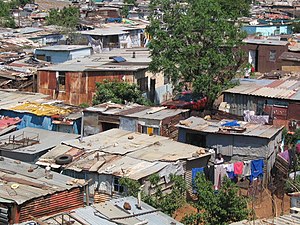 Photo Matt-80
Shanty towns are settlements of impoverished people who live in improvised dwellings made from scrap plywood, corrugated metal, and sheets of plastic. Shanty towns, which are usually built on the periphery of cities, often do not have proper sanitation, electricity, or telephone services. |
Selected picture 32
Portal:Business/Selected picture/32
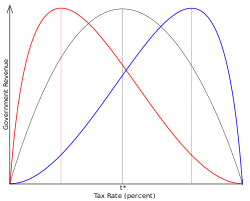 Photo credit: Vanessaezekowitz
The Laffer curve is used to illustrate the concept of taxable income elasticity, the idea that government can maximize tax revenue by setting tax rates at an optimum point. The curve was popularized by Arthur Laffer though it was widely known among economists long before that. |
Selected picture 33
Portal:Business/Selected picture/33
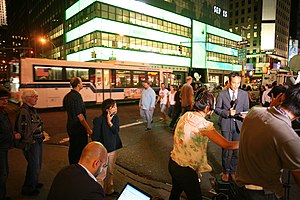 Photo Robert Scoble
Lehman Brothers Holdings Inc. was a global bankruptcy protection following the massive exodus of most of its clients, drastic losses in its stock, and devaluation of its assets by credit rating agencies. The filing marked the largest bankruptcy in U.S. history.
|
Additions
Feel free to add related featured pictures to the above list.
